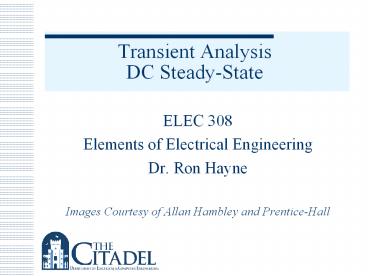Transient Analysis DC Steady-State - PowerPoint PPT Presentation
1 / 25
Title:
Transient Analysis DC Steady-State
Description:
DC Steady-State ELEC 308 Elements of Electrical Engineering Dr. Ron Hayne Images Courtesy of Allan Hambley and Prentice-Hall ELEC 308 ELEC 308 ELEC 308 ... – PowerPoint PPT presentation
Number of Views:1077
Avg rating:3.0/5.0
Title: Transient Analysis DC Steady-State
1
Transient AnalysisDC Steady-State
- ELEC 308
- Elements of Electrical Engineering
- Dr. Ron Hayne
- Images Courtesy of Allan Hambley and Prentice-Hall
2
Transient Analysis
- Scope of study
- Circuits that contain sources, switches,
resistances, inductances, and capacitances - Transients
- Time-varying currents and voltages resulting from
sudden application of sources, usually due to
switching - Transient Analysis
- Involves using circuit concepts from Chapters 1
2 - Current-voltage relationships for inductances and
capacitances involve derivatives and integrals - Create circuit equations that are differential
equations
3
First-Order RC or RL Circuits
- First-Order RC Circuits
- Contains DC sources, resistances, and a SINGLE
capacitance - First-Order RL Circuits
- Contains DC sources, resistances, and a SINGLE
inductance - Frequently used in timing applications
- Due to time constant
4
First-Order Circuit Algorithm
- Apply KCL, KVL, and/or Ohms Law to write the
circuit equation. - If equation contains integrals, differentiate
each term to produce a PURE differential
equation. - Assume a solution of the form K1K2est.
- Substitute the solution into the diff. eqn. to
determine the values of K1 and s. - Use the initial conditions to determine the value
of K2. - Write the final solution.
5
Discharge of a Capacitance
6
Discharge of a Capacitance
7
Discharge of a Capacitance
8
Discharge of a Capacitance
9
Time Constant
- Time interval t RC is called the time constant
of the circuit - After t5t, vC(t)0
10
Charging a Capacitance
11
Charging a Capacitance
12
Charging a Capacitance
13
Charging a Capacitance
- First term is STEADY-STATE RESPONSE
- Or FORCED RESPONSE
- Second term is TRANSIENT RESPONSE
14
Charging a Capacitance
15
DC Steady State
- Transient terms in the expressions for current
and voltages in RLC circuits decay to zero with
time - For DC sources, steady-state currents and
voltages are CONSTANT - For steady-state conditions with DC sources
- CAPACITANCES behave like OPEN circuits
- INDUCTANCES behave like SHORT circuits
16
Capacitance in DC Steady-State
- Remember current through a capacitance
- If voltage is constant, current is _________.
- CAPACITANCE behaves just like an ____ circuit
17
Inductance in DC Steady-State
- Remember voltage across an inductance
- If current is constant, voltage is _________.
- INDUCTANCE behaves just like a ______ circuit
18
Steady-State DC Analysis
- Find vx and ix for t gtgt 0
19
Exercise 4.3
- Find va and ia for t gtgt 0
20
RL Transient Analysis
- Find i(t) and v(t)
21
RL Transient Analysis
- Time interval t L/R is called the time constant
of the circuit - After t5t, i (t)2
22
Example 4.3
- Find i(t) and v(t)
23
Example 4.3
24
Exercise 4.6
- Find i(t) and v(t)
25
Summary
- Transient Analysis
- First Order RC Circuits
- First Order RL Circuits
- DC Steady State































